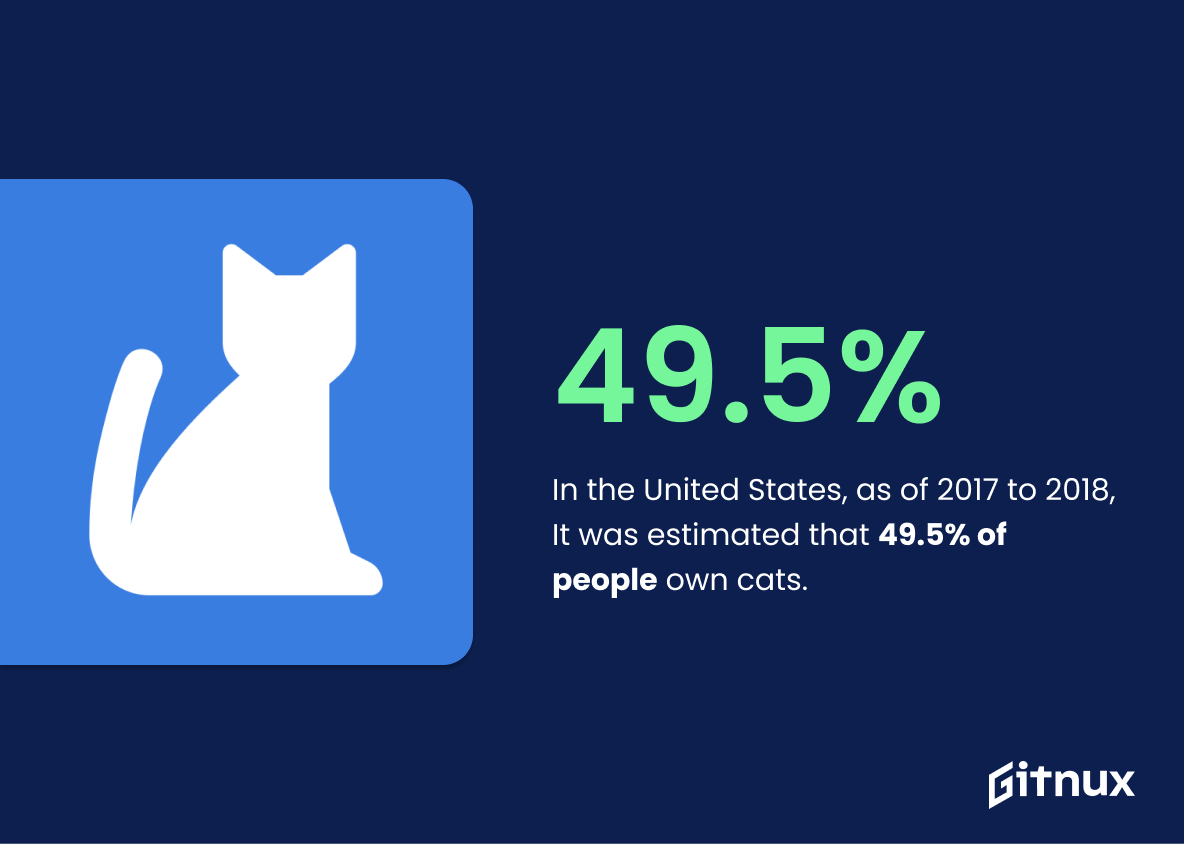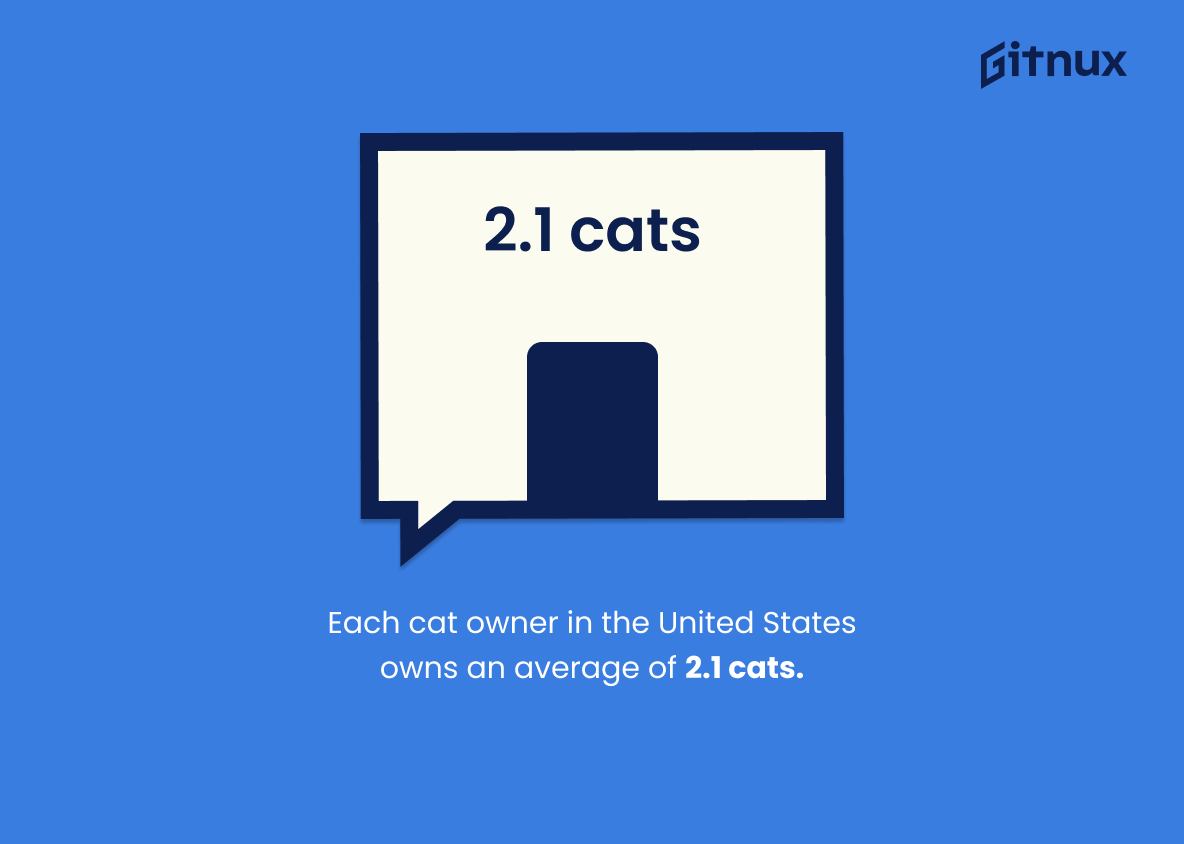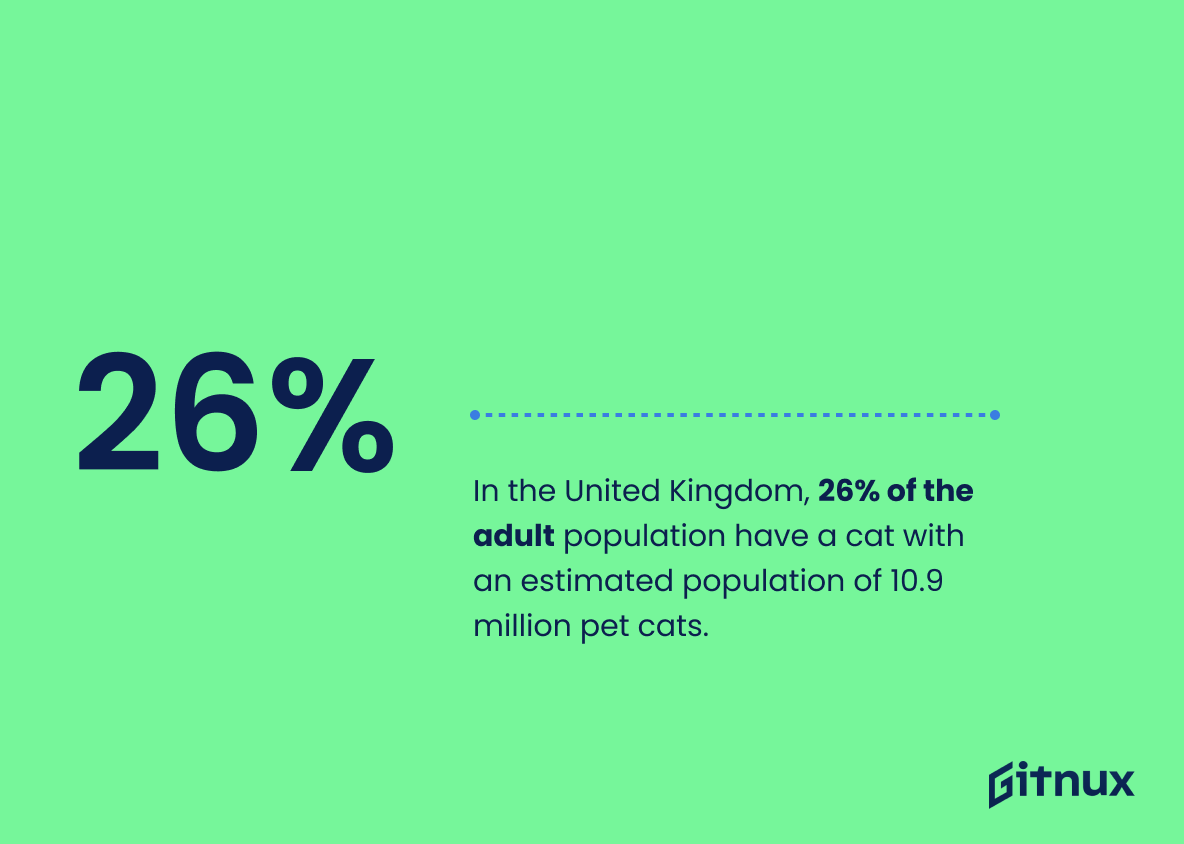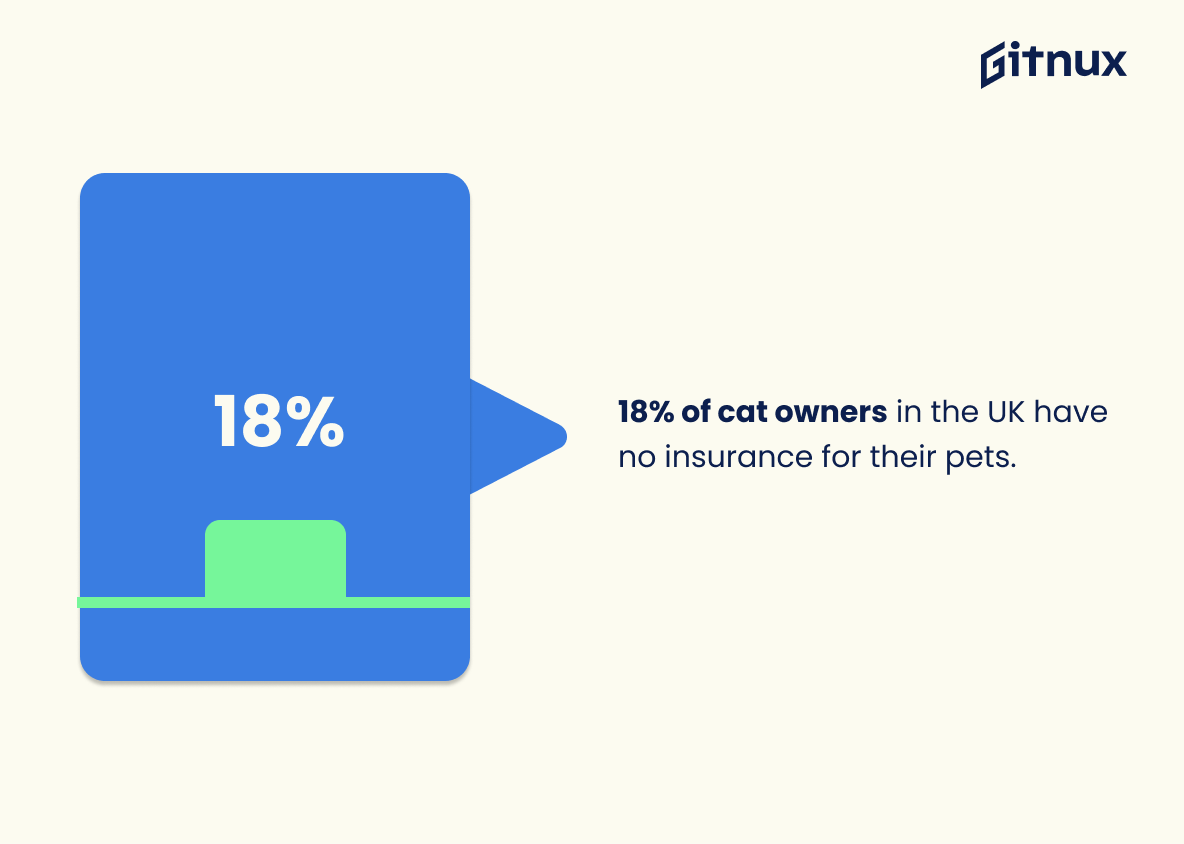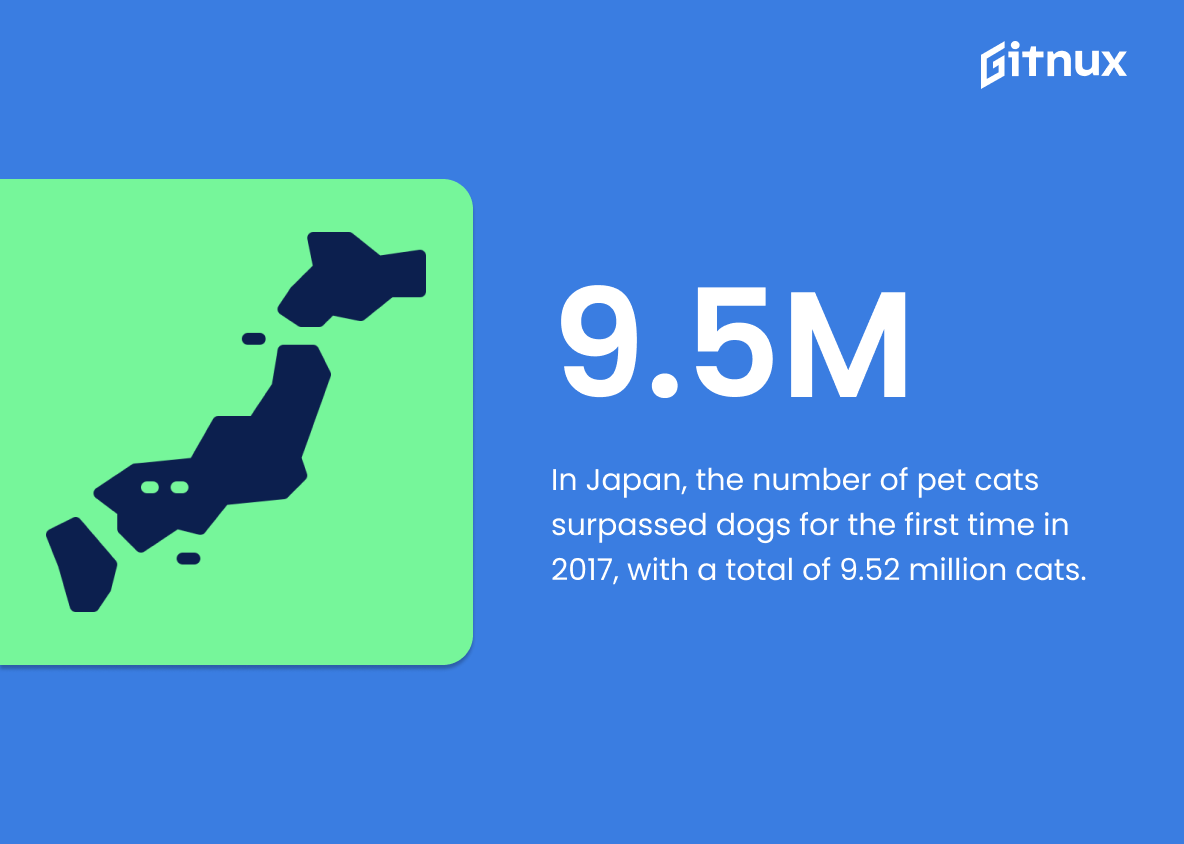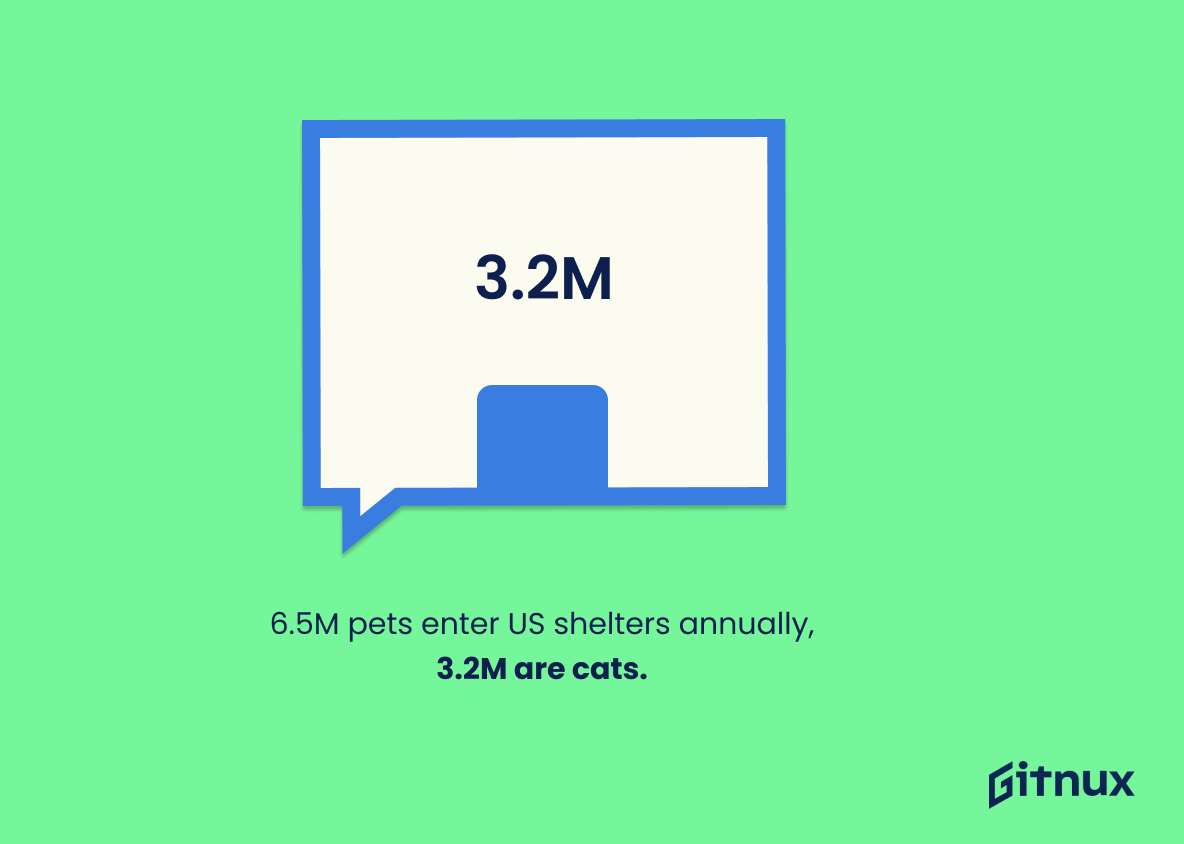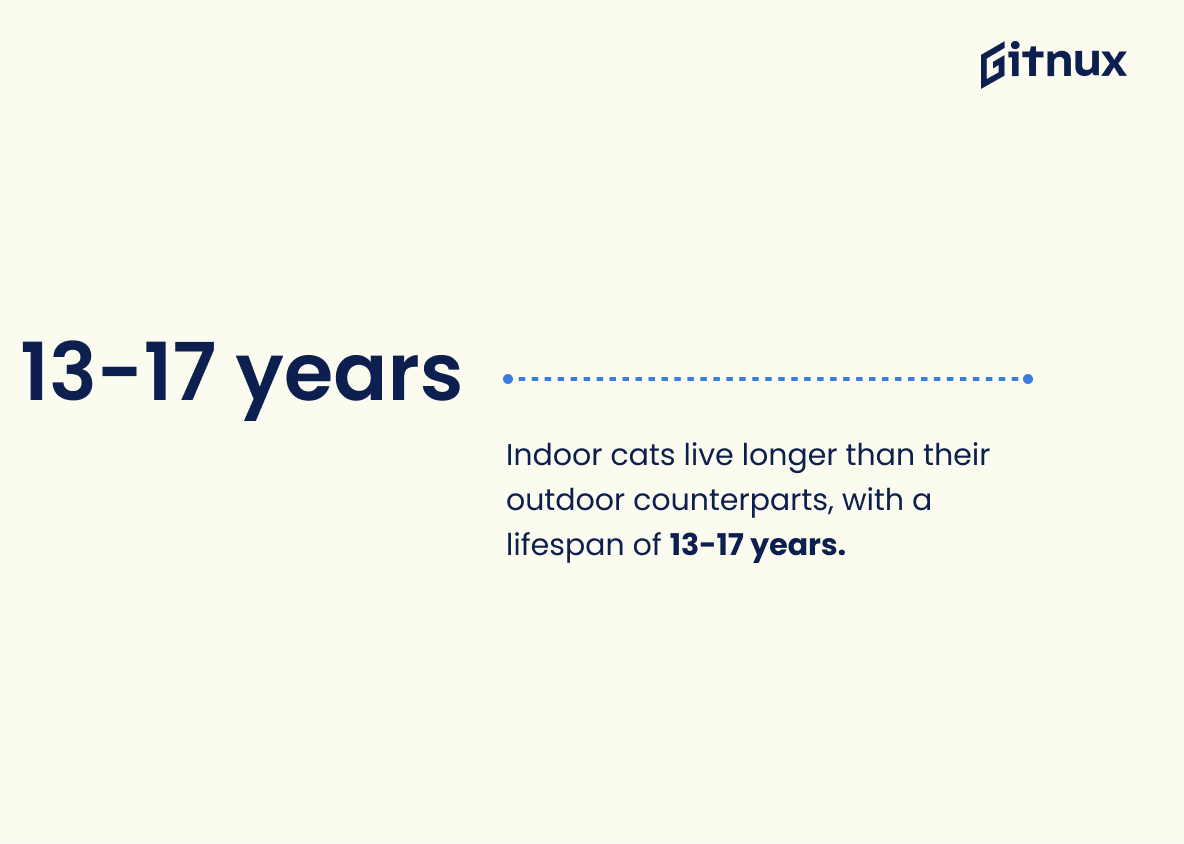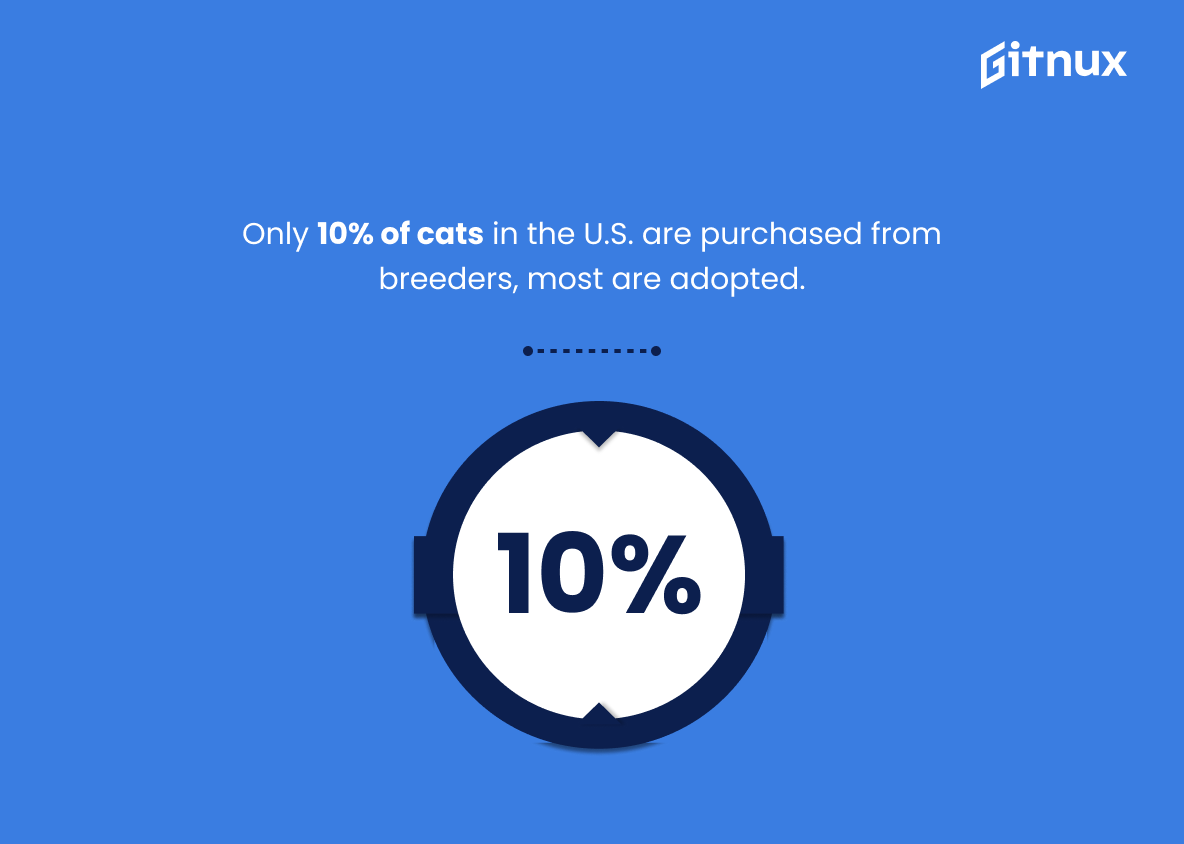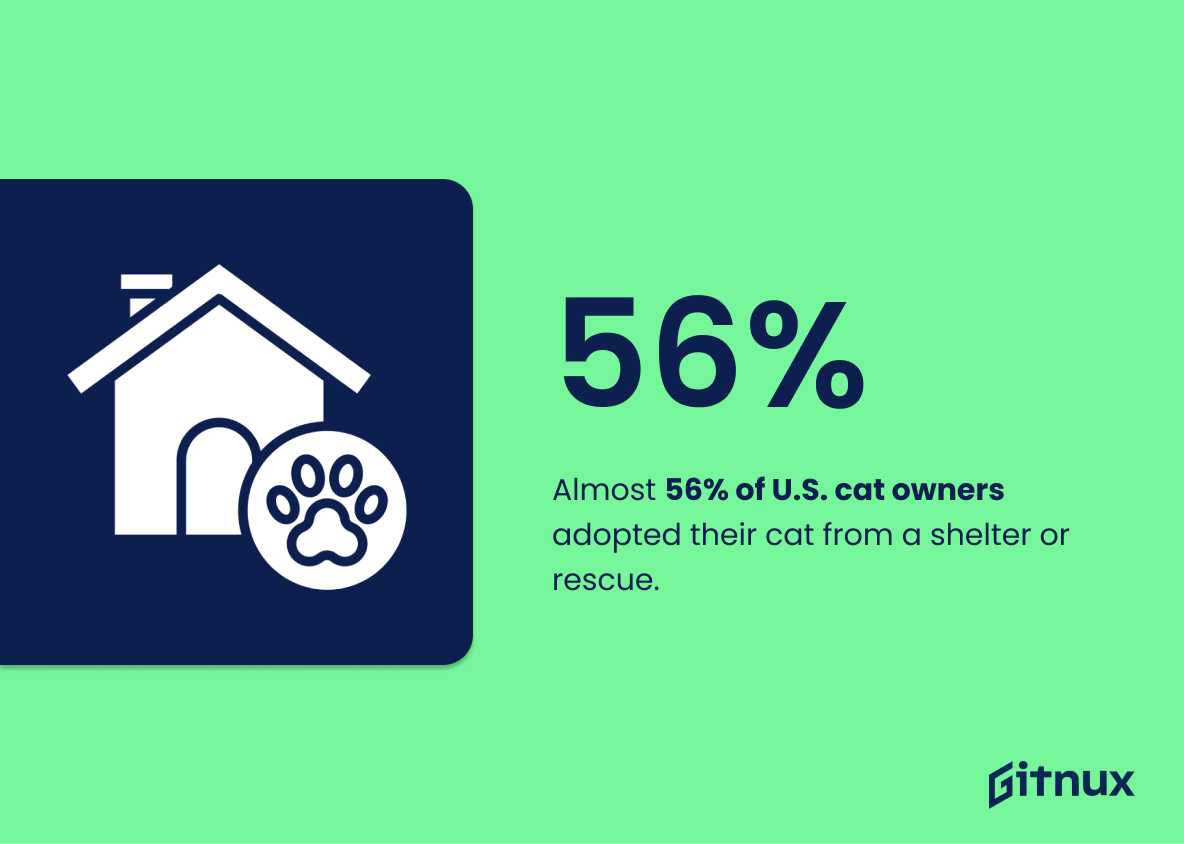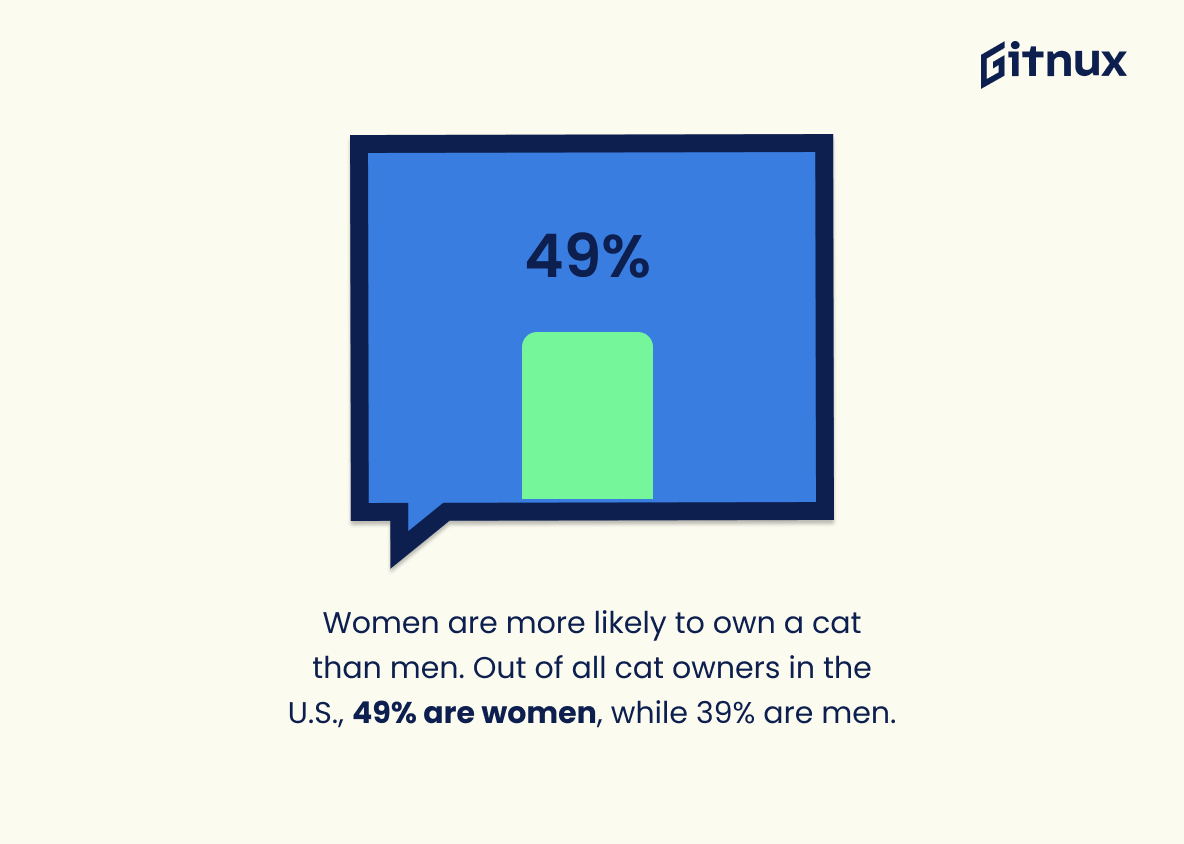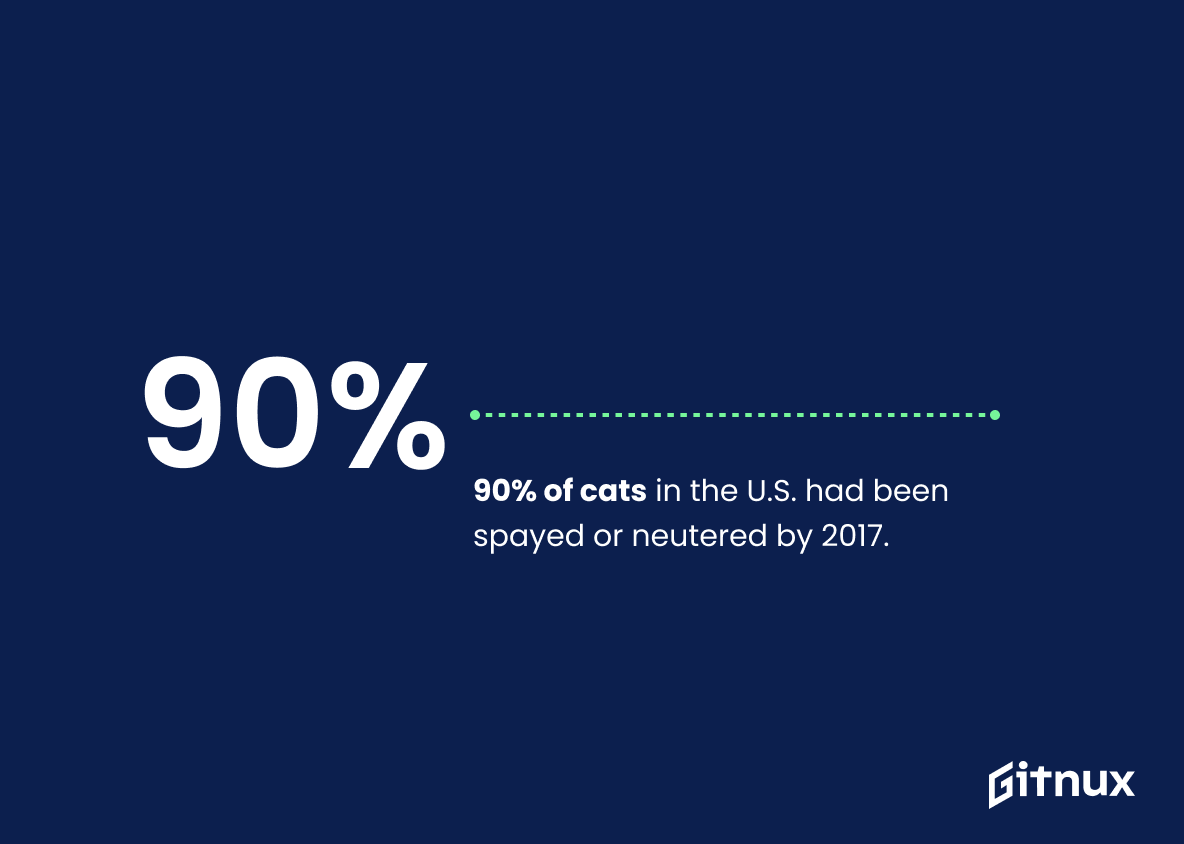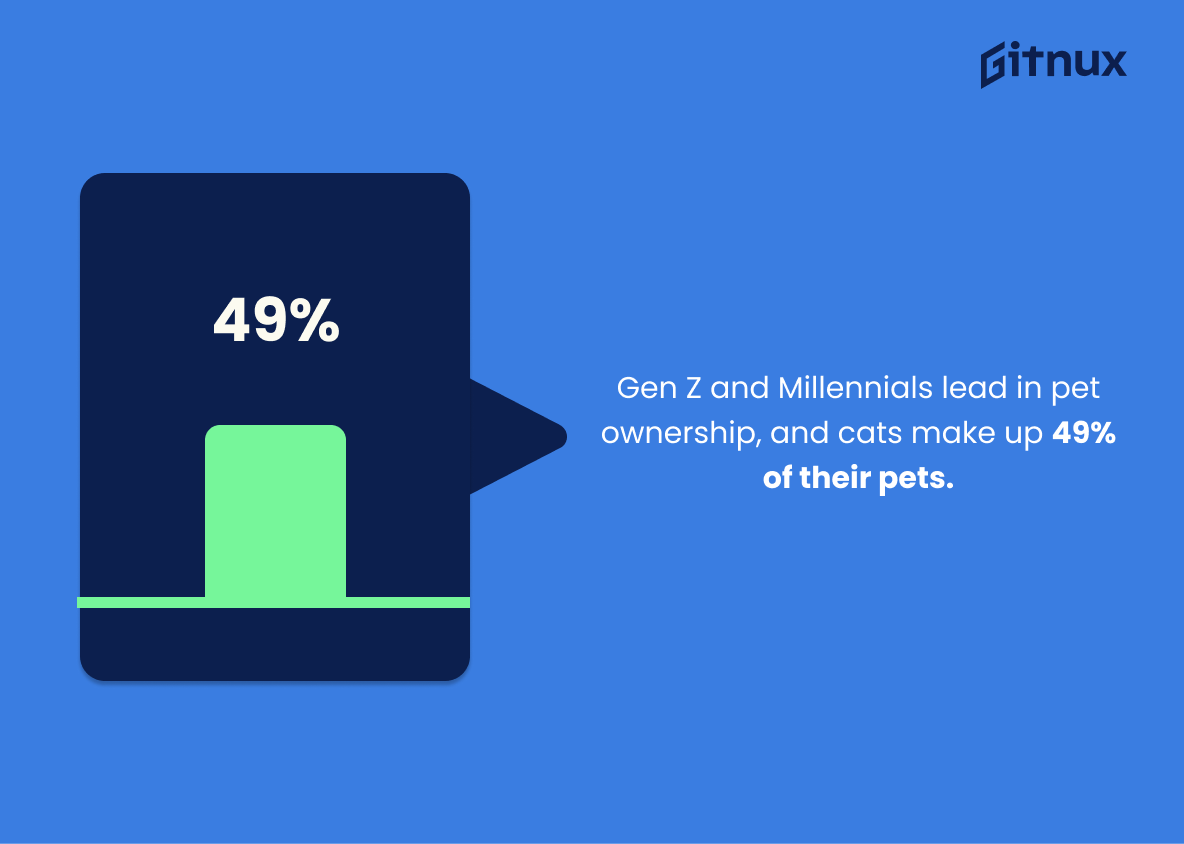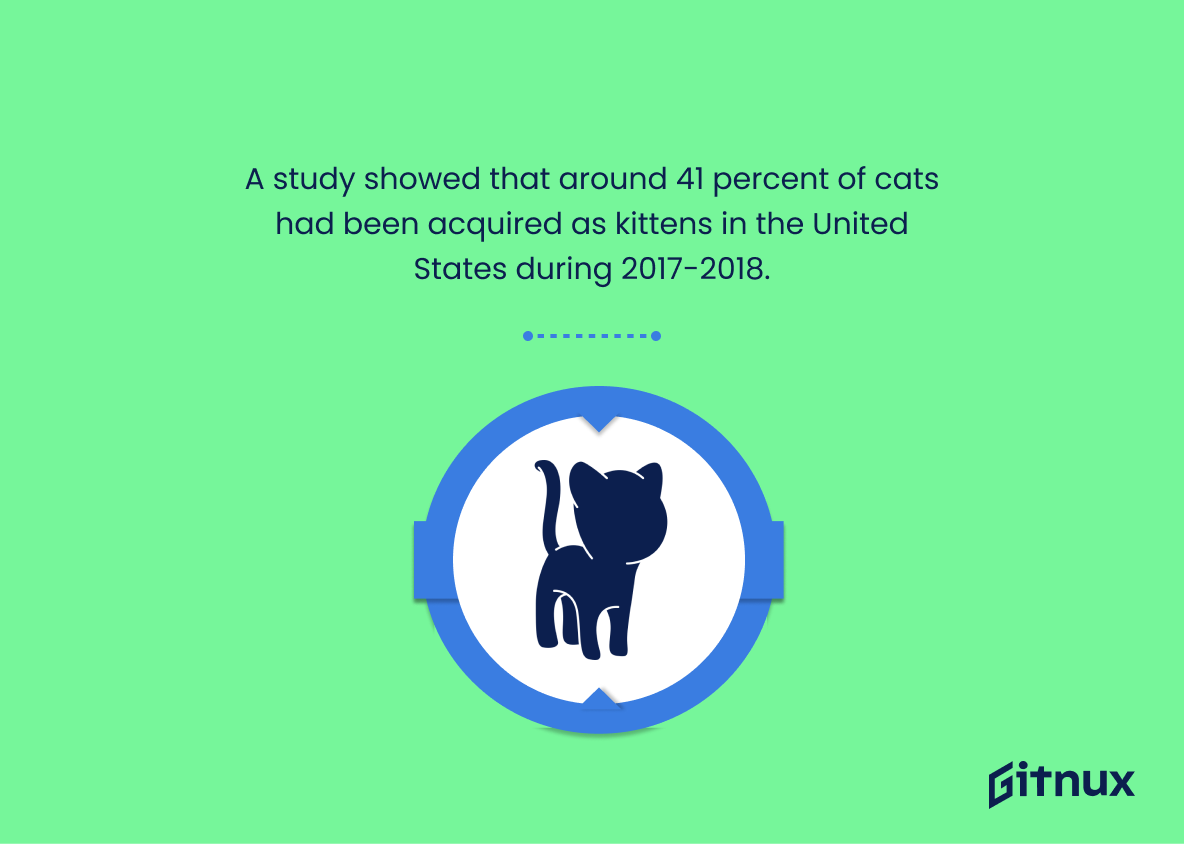Becoming a cat parent doesn’t just require bringing home a furry friend, it involves stepping into a world where love, companionship, and care become an everyday affair. The statistics revolving around cat ownership might surprise you, tossing a glimpse into how these adorable creatures are not only taking up space in our homes, but also in our hearts. Whether you are a seasoned cat parent, contemplating bringing home your first feline, or simply a cat enthusiast, you’ll find this comprehensive analysis of cat ownership statistics both intriguing and insightful. Poke into the intriguing world of feline companions and understand the depth of human-cat relationships like never before. After all, numbers can reveal surprising tales – even when they’re about whiskers and claws.
The Latest Cat Ownership Statistics Unveiled
In the United States, as of 2017 to 2018, It was estimated that 49.5% of people own cats.
Perusing the statistic that nearly half of Americans were proud feline owners during 2017 and 2018 offers us an enlightening glimpse into the cat-human dynamic in the United States. This figure serves as a cornerstone in painting a robust picture of the cultural, personal, and lifestyle preferences that define cat ownership. It underscores the growing appreciation for cats and the potential influence that they wield over consumer behavior, whether that be pet-related products or cat-themed content. Naturally, such a substantial percentage also implies notable changes in societal attitudes towards pet ownership, along with potential shifts in relevant markets and industries. Therefore, this ratio provides a pulse on societal trends, making it an invaluable insight for anyone delving into cat ownership statistics.
Each cat owner in the United States owns an average of 2.1 cats.
Undeniably, the fact that each cat owner in the United States owns an average of 2.1 cats provides a captivating focal point in exploring the realm of feline companionship. This delightful decimal captures, in numeric form, just how entrenched the passion for these furry friends is among their human guardians.
Beyond simply stating a fact, it weaves a tale of boundless affection that transcends the confines of a single cat ownership – suggesting that for many, one is simply not enough. Evidently, this multi-cat phenomenon paints an intriguing picture of the cat-laden landscapes of American households, creating an insightful backdrop that frames the percentages and figures scattered throughout the blog post and enriches our understanding.
By indicating a trend towards multiple cat ownership it fosters insightful discussions around pet care costs, space considerations, inter-cat dynamics, and so on. This, therefore, doesn’t just underscore the importance of cats in the American household, but also sets the stage for further discussion around the implications and intricacies of owning not just one, but multiple cats.
In the United Kingdom, 26% of the adult population have a cat with an estimated population of 10.9 million pet cats.
Delving into this fascinating realm of feline dominance, one cannot turn a blind eye to the notable figure – a roaring 26% of Britain’s adult population lays claim to a purring pet cat. The number translates to an astounding 10.9 million domestic cats gracing the United Kingdom. This figure sheds light on the immense popularity and widespread acceptance of pet cats within the British society; it creates a compelling narrative that cats have indeed clawed their way into the hearts, and homes, of a significant quarter of adults in the UK. This narrative is essential to understanding trends in pet ownership, the pet industry’s direction, and even sociological aspects of life in Britain.
18% of cat owners in the UK have no insurance for their pets.
Diving straight into the feline world with crispy data, the figure stating that ‘18% of cat owners in the UK have no insurance for their pets’ adds a hint of intrigue. This statistic that stands like a beacon may suggest a subtle lack of awareness or perhaps an underestimation of risks associated with pet health. Which, in turn, might lead to unexpected financial burdens. Undoubtedly, this piece of information urges cat owners to reassess their situation, painting a more holistic picture in the canvas of the blog post about “Cat Ownership Statistics”, and in doing so promoting contemplation on the responsibility that accompanies the joy of owning a feline friend.
In Australia, 29% of households own a cat.
Shining a spotlight on Australia, a notable segment of households, precisely 29%, reside harmoniously with a purring friend. Such a number, not only enriches the narrative of our blog post on Cat Ownership Statistics by unveiling a sizeable part of Australia’s feline affection but also accentuates the demographic and cultural intricacies linked to pet ownership. This percentage provides a solid groundwork for a robust discussion around patterns of cat owners, societal attitudes towards feline companionship, and the potential demand for cat-related products or services in the land down under. Not to mention, it’s a starting point for intriguing comparisons with cat ownership statistics in other parts of globe and how they shape our complete understanding of our furry friends’ place in our households and hearts.
In Japan, the number of pet cats surpassed dogs for the first time in 2017, with a total of 9.52 million cats.
Highlighting Japan’s feline fascination, this intriguing piece of data in 2017 crowned cats as the new royalty within Japanese households, dethroning dogs for the first time in the pet kingdom. With a whopping total of 9.52 million cats claiming their spots on the couch, this diverse and cat-ivating development signals a shift in the nation’s pet-ownership preferences. In the panorama of a blog post about Cat Ownership Statistics, such an insight serves as a compelling testament to the growing global trend of cat ownership, offering readers a paws-itive perspective on the charm and appeal these whiskered friends bring into our homes.
Approximately 6.5 million companion animals enter U.S. animal shelters nationwide every year, and of those, approximately 3.2 million are cats.
Highlighting the statistic that an estimated 3.2 million cats enter U.S. animal shelters yearly weaves a telling narrative in the context of cat ownership. It provides a significant backdrop illustrating the sheer number of felines requiring homes each year. In addition, it infuses a sense of urgency for prospective cat owners to consider adopting from shelters, simultaneously addressing the problem of homeless felines and offering a potential solution. Furthermore, it enables readers to comprehend the scale of cat ownership in the U.S., stimulating conversations about responsible pet ownership, housing challenges, and the impact of spaying and neutering pets.
Indoor cats live longer than their outdoor counterparts, with a lifespan of 13-17 years.
Diving into these statistics about feline longevity gives prospective cat owners an intriguing insight. They reveal an interesting facet of cat ownership: lifestyle matters. By choosing to keep their feline companions indoors, owners could potentially extend their cat’s life by several years, shifting not just the lifespan but also influencing veterinary costs and health management. This statistic forms a compelling argument in favor of indoor living arrangements for cats, shaping decisions about how to best care for a pet. In the broad landscape of cat ownership, this fact holds significant sway, prompting conversations about cat safety, health, and quality of life.
In Canada, cat ownership has been increasing since 2016, with an estimated 9.3 million cats living in Canadian households in 2020.
Making sense of the numbers, it is intriguing to observe how Canada’s love for felines has been on a steady climb since 2016, culminating in an impressive estimated 9.3 million cats gracing Canadian homes in 2020. This striking upward trajectory provides a remarkable testament to the growing affection Canadians have for these whiskered companions, with their number suggesting a significant shift in pet preference trends. The reasons behind such an increase could be many – from changing lifestyle patterns to increased awareness about pet adoption, this statistic serves as invaluable insight for understanding Canada’s pet market dynamics. Whether you’re a cat lover, pet industry stakeholder, or curious reader, this elucidating fact underscores the notable cat-ward trend in Canada’s pet ownership landscape.
Only 10% of cats in the U.S. are purchased from breeders, most are adopted.
Unveiling the surprising truth, the slender fraction of 10% of cats in the U.S. being purchased from breeders, sheds light on the vast majority’s origin—adoption. This pivotal data point not only emphasizes the extensive preference for adoption but also the potential decrease in demand for breed-specific felines, which may influence a breeder’s business sustainability in the American Market. If you are considering becoming part of the cat owners’ community, this insight can certainly guide your decision-making process between adopting and purchasing from a breeder, simultaneously bringing you closer to the prevailing habits of fellow cat enthusiasts in the U.S.
Almost 56% of U.S. cat owners adopted their cat from a shelter or rescue.
Highlighting the fact that nearly 56% of U.S. cat owners have chosen to adopt their feline friends from a shelter or rescue underscores an encouraging trend that pervades cat ownership culture. Within the numbers lies a story of compassion and responsible pet ownership, hinting at the increasing societal preference for adopting over buying. This data point serves as a beacon illuminating the possibility of a brighter future for sheltered and rescued cats. In the grand narrative of cat ownership, it’s a sign of positive change, nudging readers towards considering adoption over other methods when choosing their next purring companion.
Women are more likely to own a cat than men. Out of all cat owners in the U.S., 49% are women, while 39% are men.
Diving into the feline world within the U.S, we unearth a fascinating tidbit of information that provides a gender-based twist to cat ownership. As our paws hit the sands of curiosity, we witness an intriguing pattern, where the silhouette of a woman stands beside a purring pet more frequently than that of a man. Demonstrating this, a striking 49% of all cat owners identify as women, comparatively overshadowing the 39% of men.
Painting a more distinctive and comprehensive cat-ownership landscape, this statistic not only illuminates the prevalent gender trends in pet companionship but also lays a foundation for deeper inquiries. It spurs questions about the why’s and how’s behind this discrepancy. Is it due to differing preferences, lifestyle considerations or socio-cultural factors? It’s like a yarn ball of curiosity, unraveling more layers the deeper you delve in.
Expressing such percentile difference not only gives your blog post more depth but it adds a color of personal connection and ensures readers’ engagement. By presenting facts with a face- both human and feline- your blog post becomes more than a mere data report. It’s a compelling cat tale with compelling cat tales. or should I say, tails.
90% of cats in the U.S. had been spayed or neutered by 2017.
Highlighting the statistic that 90% of U.S. cats had been spayed or neutered by 2017 presents a compelling insight into the collective responsibility shouldered by cat owners across the nation. It underscores a nationwide commitment to pet population control, helping to alleviate pressure on shelters and rescues. This numeric fact brings to light the magnitude of preventive efforts made to fend off burgeoning feline populations and helps readers to discern the urgency of continuing such practices. This piece of data encapsulates a shared vision for healthier and more sustainable cat communities across the U.S., making it a pivotal touchstone in the descriptive tapestry of cat ownership statistics.
Gen Z and Millennials lead in pet ownership, and cats make up 49% of their pets.
In the digital era’s pet-loving universe, the above statistic serves as the lunar mission, unfolding a largely untapped galaxy of cat ownership. The Gen Z and Millennials, being the primary drivers of this age, spotlight a significant behavioural aspect as trendsetters. These generations don’t merely dominate the pet sector but sway it towards a near equal alliance between eons-old rivals – cats and dogs. This captivating feline fascination provides a prolific foundation for anyone venturing to pen down insightful blog posts on cat ownership statistics. Without a doubt, the next chapters in the pet industry’s narrative could deeply be influenced by these evolving trends.
A study showed that around 41 percent of cats had been acquired as kittens in the United States during 2017-2018.
Illuminating a trend that cannot be ignored, the study’s finding that approximately 41% of cats had been acquired as kittens in the US during 2017-2018 offers a revealing snapshot of American cat ownership patterns. It underscores the popularity of embracing our feline friends from their earliest stages of life, proving the prevalence of kitten adoption. This figure resonates with themes of nurturing, responsibility, and the human desire to witness growth; fundamentals that are at the heart of pet ownership. Nestled within this statistic, we unearth our shared human story- our tendency to care for and raise young, be they human or feline. This is a ray of insight into the compassionate side of American culture and cat-owning trends, adding a layer of depth and dimension to any analysis or discussion about cat ownership statistics.
Approximately one in two households in Germany owns a pet, and among these, cats are the most popular, with 14.8 million cats.
Delving into the realm of pet ownership in Germany, we unearth a fascinating revelation. Almost every second home in this country resonates with the patter of tiny paws or the soft purr of a contented feline. Among the flurry of feathers, fur, and fins, cats have gracefully climbed to the top as favored companions, their presence marked by a staggering population of 14.8 million.
In an exploration of cat ownership statistics, this nugget of insight shines a spotlight on Germany’s affection for these independent and charismatic creatures. It elevates the importance of the nation in the global landscape of feline pet ownership, offering blog readers an intriguing perspective that extends beyond regional boundaries.
Moreover, it reflects a strong cat culture, which potentially translates into a vast and engaged audience for pet-related content, suggesting that any blog focusing on feline companionship or cat care could find a ready, receptive audience in Germany. Just as a cat, with its keen eyes and alert mind, misses nothing – this significant cornerstone in German pet preferences should certainly not be overlooked in a comprehensive discussion about worldwide cat ownership statistics.
In Spain, cats are the second most owned pet, making up 23% of total pets owned.
Navigating the landscape of pet ownership in Spain, it’s salient to note that feline companion animals appear to hold a significant place in Spanish households. The statistic that cats comprise 23% of total pet ownership sets the fur ball rolling on the discussion about cats’ popularity. This pint-sized fact signposts an intriguing rise in their domestication and potentially caters to a varied range of topics – from the socioeconomic factors driving this trend, pet industry growth, the impact on related businesses like veterinary care, pet food, to the shifting societal norms and preferences. This alone could beacon a torrent of avid cat enthusiasts who are curious or conscientious about their choice of pet. Drawing the reader’s attention to this numerical marker further enriches their understanding of feline popularity, adds a dash of credibility to the blog, and paints a more evocative picture of cat ownership in Spain.
Russian cat owners spend an average of 1,694 rubles ($23) a month on their pets.
In the realm of feline affection and finances, the intriguing figure of Russian cat owners investing an average of 1,694 rubles ($23) on their cherished companions each month becomes a headline in the narrative. Nestled snugly within the broader picture of Cat Ownership Statistics, this detail offers us not merely numbers, but a tangible representation of the fiscal and emotional commitment involved in pet ownership. It illustrates the marriage of love and economy, breathing life into the typically dry stats, making it an essential bite-size piece of the puzzle. Imagine it – a Russian cat aficionado, browsing through pet supplies online, diving deep into their wallet month after month to keep their feline companion healthy and happy. A gentle reminder of the investment we make when we open our homes – and our hearts – to pets.
Conclusion
Unquestionably, the world’s love affair with cats is a phenomenon that continues to grow. Pausing to consider cat ownership statistics not only unravels a massive global trend but also presents an insightful narrative about human’s close bond with these irresistible creatures. From their impressive population numbers to their economic impact, cats have indeed claimed a significant place in our homes, hearts, and societies. As we continue to learn more about their unique needs and behaviors, we undoubtedly also increase the value we ascribe to their companionship. Ultimately, the benefits of cat ownership are both profound and unequivocal. It’s your turn now to partake in this extraordinary journey of feline friendship and love.
References
0. – https://www.vcahospitals.com
1. – https://www.www.packagedfacts.com
2. – https://www.www.themoscowtimes.com
3. – https://www.www.avma.org
4. – https://www.www.statista.com
5. – https://www.www.iii.org
6. – https://www.www.pdsa.org.uk
7. – https://www.www.pfma.org.uk
8. – https://www.www.argos.co.uk
9. – https://www.veterinary-practice.com
10. – https://www.kb.rspca.org.au
11. – https://www.www.americanpetproducts.org
12. – https://www.www.humanesociety.org
13. – https://www.www.japantimes.co.jp
14. – https://www.www.aspca.org
